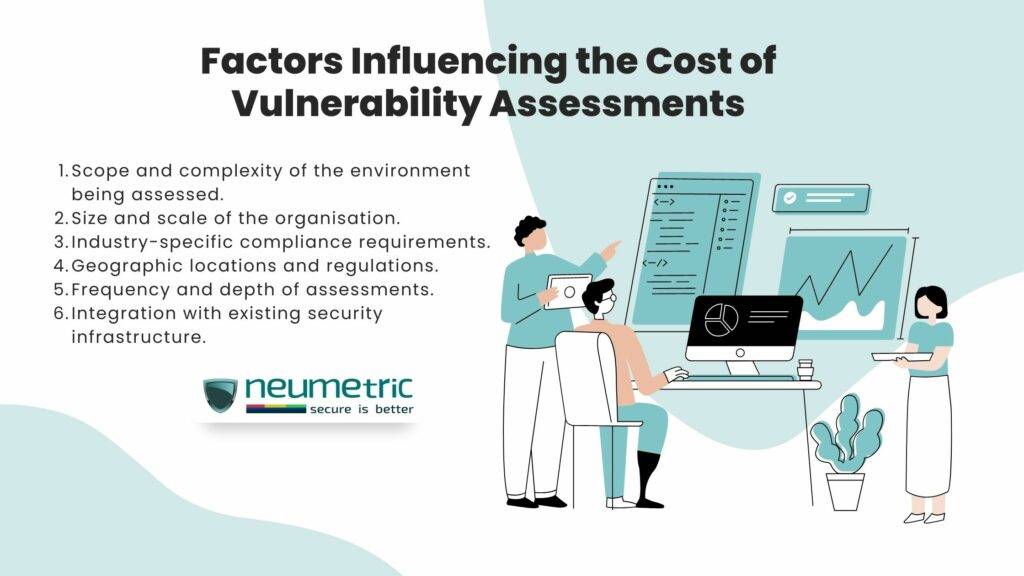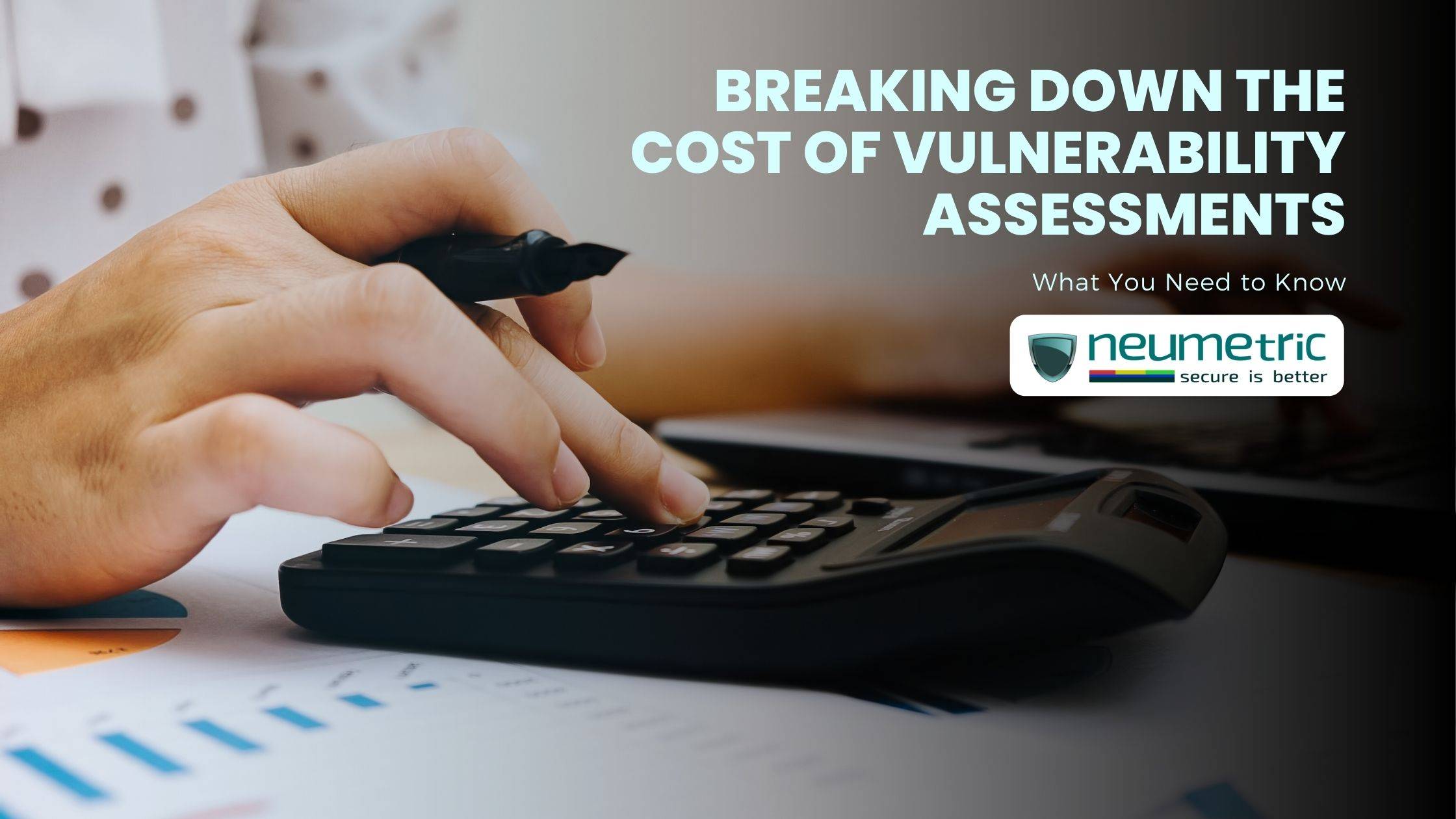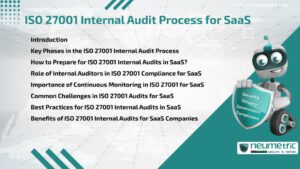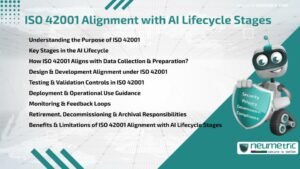Table of Contents
ToggleIntroduction
Vulnerability assessments are critical in cybersecurity, enabling organisations to proactively identify & address weaknesses that could be exploited by attackers. This Journal focuses on the cost of vulnerability assessments, exploring factors such as scope, complexity, expertise & tools, helping organisations make informed decisions & optimise their cybersecurity investments.
Vulnerability assessments refer to the process of identifying & evaluating potential weaknesses or vulnerabilities in a system, network or application. This involves conducting systematic scans, tests & analysis to uncover security flaws that could be exploited by attackers. By pinpointing these vulnerabilities, organisations can take proactive measures to strengthen their cybersecurity posture & mitigate potential risks.
Vulnerability assessments play a crucial role in cybersecurity by providing organisations with valuable insights into their security gaps & potential entry points for cyber threats. By identifying vulnerabilities before attackers can exploit them, organisations can implement appropriate safeguards, such as patching vulnerabilities, updating security configurations or strengthening access controls. This proactive approach helps prevent unauthorised access, data breaches & other malicious activities, enhancing the overall security posture of the organisation.
This Journal aims to explore & break down the cost aspects associated with vulnerability assessments. It will delve into the various factors that contribute to the cost of conducting vulnerability assessments, including the scope & complexity of the system, the expertise required, the tools & technologies utilised & the frequency of assessments. By understanding the cost implications, organisations can make informed decisions regarding their cybersecurity investment & allocate resources effectively to ensure robust security while optimising their budget.
Understanding Vulnerability Assessments
Vulnerability assessments are systematic evaluations conducted to identify & assess potential weaknesses in systems, networks or applications. The primary objective is to uncover security vulnerabilities that could be exploited by attackers. By scanning, testing & analysing these vulnerabilities, organisations gain insights into their security posture & can take proactive measures to strengthen their defences. The assessments aim to identify vulnerabilities, prioritise them based on risk & provide recommendations for remediation.
There are different types of vulnerability assessments, each focusing on specific areas of an organisation’s infrastructure:
- Network Vulnerability Assessment: This assessment evaluates the security of a network by identifying vulnerabilities in network devices, routers, switches, firewalls & other components. It helps identify weak configurations, outdated firmware or misconfigurations that could expose the network to potential threats.
- Application Vulnerability Assessment: This assessment focuses on identifying vulnerabilities within software applications, such as web applications or mobile apps. It scans for common vulnerabilities like injection flaws, Cross-Site Scripting [XSS], insecure authentication or Insecure Direct Object References [IDOR].
- Wireless Network Vulnerability Assessment: This assessment targets wireless networks & their associated devices, such as Wi-Fi routers & access points. It helps identify vulnerabilities that could lead to unauthorised access, data interception or network compromise.
By conducting these different types of vulnerability assessments, organisations can gain a comprehensive understanding of their security weaknesses across various aspects of their infrastructure, enabling them to prioritise & address the most critical vulnerabilities.
Vulnerability scanning tools & methodologies are crucial for conducting effective vulnerability assessments. These tools automate the process of identifying potential weaknesses & provide organisations with valuable insights into their security posture. They include:
- Automated Scanning Tools: These tools use predefined vulnerability databases & scan systems, networks or applications for known vulnerabilities. Examples include Nessus, OpenVAS & Qualys.
- Manual Testing: This involves the expertise of cybersecurity professionals who manually probe systems, networks & applications for vulnerabilities using techniques like code review, penetration testing & social engineering assessments.
- Web Application Scanning: Tools like Burp Suite, Acunetix & OWASP ZAP focus specifically on scanning web applications for vulnerabilities like SQL injection, cross-site scripting & insecure direct object references.
- Continuous Monitoring: Vulnerability scanning should be an ongoing process. Continuous monitoring tools conduct regular scans to identify new vulnerabilities & track remediation progress. They integrate with asset management systems & provide real-time alerts for newly discovered vulnerabilities.
By utilising a combination of automated scanning tools, manual testing, web application scanning & continuous monitoring, organisations can adopt a comprehensive approach to vulnerability assessments, ensuring a proactive stance towards security & prompt remediation of vulnerabilities.
Factors Influencing the Cost of Vulnerability Assessments

- Scope & complexity of the environment being assessed: The cost of vulnerability assessments is influenced by the size & complexity of the environment being assessed. Larger networks, multiple systems & diverse infrastructure components require more time & resources to assess thoroughly, resulting in higher costs. Additionally, complex environments with intricate architectures or specialised technologies may necessitate the involvement of specialised experts or tools, further impacting the cost.
- Size & scale of the organisation: The size & scale of an organisation play a role in the cost of vulnerability assessments. Larger organisations with a larger number of assets & systems may require more extensive scanning & testing, leading to increased costs. The complexity of the organisational structure, including multiple branches or remote locations, may also affect the cost as it may require additional effort to assess each site adequately.
- Industry-specific compliance requirements: Organisations operating in regulated industries like finance, healthcare or government are often subject to specific compliance requirements. Compliance-driven vulnerability assessments involve additional considerations & assessments to meet industry standards, resulting in higher costs. Compliance audits, documentation & additional security controls may be necessary to satisfy the compliance requirements.
- Geographic locations & regulations: Geographic locations & associated regulations can impact the cost of vulnerability assessments. Different regions or countries may have specific data protection & privacy regulations that organisations need to adhere to. Conducting assessments across multiple jurisdictions may require additional expertise, legal considerations or translation services, thereby affecting the overall cost.
- Frequency & depth of assessments: The frequency & depth of vulnerability assessments can affect their cost. Regular assessments are essential to maintain a strong security posture, but conducting assessments more frequently may result in higher costs due to increased resource allocation. Similarly, deeper assessments involving comprehensive manual testing, penetration testing or red teaming exercises require more specialised expertise & time, leading to higher costs compared to basic automated scans.
- Integration with existing security infrastructure: The cost of vulnerability assessments can be influenced by the integration with an organisation’s existing security infrastructure. If the assessment tools & methodologies need to be integrated with existing security systems, such as Security Information & Event Management [SIEM] or vulnerability management platforms, additional effort & customization may be required, leading to increased costs.
It’s important for organisations to consider these factors when budgeting for vulnerability assessments, as they can vary based on the specific needs & characteristics of the organisation & its environment.
Cost Components of Vulnerability Assessments
Vulnerability assessments come with various cost components that organisations need to consider. These include tools & software licensing fees, internal resource allocation for personnel & expertise, external consulting services, remediation & mitigation costs, as well as ongoing monitoring & maintenance expenses. Understanding these cost factors is essential for effective budgeting & decision-making in cybersecurity investments.
- Tools & software licensing fees: One cost component of vulnerability assessments is the acquisition or licensing of tools & software. Vulnerability scanning tools, vulnerability management platforms & other specialised software often come with associated costs. Organisations may need to consider upfront fees, annual subscriptions or licensing fees based on the number of assets or users. The complexity & features of the tools can also influence the cost.
- Internal resource allocation (personnel & expertise): Conducting vulnerability assessments requires internal resources, including personnel & expertise. Organisations may allocate dedicated cybersecurity staff or assign existing personnel to perform vulnerability assessments. The cost involves salaries, training & maintaining a skilled team. Hiring external experts or consultants with specialised knowledge may incur additional costs, particularly for complex or niche assessments.
- External consulting services: In some cases, organisations may engage external consulting services for vulnerability assessments. These services may involve third-party cybersecurity firms or independent consultants who provide expertise, experience & specialised tools. External consulting costs can vary based on the duration, complexity & scope of the assessment. Factors such as reputation, credentials & experience of the consultants can also impact the cost.
- Remediation & mitigation costs: Assessments often uncover vulnerabilities that require remediation & mitigation. These costs can arise from fixing vulnerabilities, implementing security controls, applying patches or addressing configuration weaknesses. The expenses associated with remediating identified vulnerabilities are an important consideration in the overall cost of vulnerability assessments.
- Ongoing monitoring & maintenance expenses: Vulnerability assessments are not one-time events but rather an ongoing process. After the initial assessment, organisations need to invest in ongoing monitoring & maintenance. This includes periodic or continuous vulnerability scanning, regular patch management, configuration updates & monitoring of security controls. Ongoing monitoring & maintenance expenses ensure that vulnerabilities are continuously monitored & addressed, contributing to the overall cost of vulnerability assessments.
Variations in Cost Structures
The cost structures of vulnerability assessments can vary based on several factors. Differences between in-house & outsourced assessments, the chosen assessment provider & the pricing models adopted all contribute to the overall cost. Understanding these variations is crucial for effective budgeting & decision-making in cybersecurity investments.
- Differences between in-house & outsourced vulnerability assessments: The cost structure can vary significantly between in-house vulnerability assessments conducted by an organisation’s internal team & outsourced assessments performed by external vendors or consultants. In-house assessments may involve primarily the cost of internal resources, such as personnel, expertise & tools. On the other hand, outsourced assessments typically incur costs for hiring external experts, consulting fees & potentially additional expenses like travel or accommodation, depending on the engagement model.
- Cost variances based on the chosen assessment provider or vendor: The cost of vulnerability assessments can vary based on the chosen assessment provider or vendor. Different providers may offer varying levels of expertise, experience & service quality, which can influence the cost. Higher-priced providers may offer comprehensive assessments, more extensive reporting or additional value-added services. The reputation, certifications & specialisation of the assessment provider can also impact the cost structure.
- Pricing models (e.g., per scan, per IP address, subscription-based): The pricing models adopted by assessment providers contribute to the cost structure. Common pricing models include per scan, where organisations pay based on the number of scans performed; per IP address, where the cost is based on the number of IP addresses assessed or subscription-based models, where organisations pay a recurring fee for ongoing vulnerability assessments & related services. Each pricing model has its advantages & considerations & organisations should choose the one that aligns with their needs & budget.
Considering these factors helps organisations understand the variations in cost structures for vulnerability assessments. It allows them to make informed decisions about whether to conduct assessments in-house or outsource, select the most suitable assessment provider & choose a pricing model that aligns with their budget & requirements.
Cost-Effective Strategies for Vulnerability Assessments
- Prioritising critical assets & high-risk areas: Focus resources on assessing critical assets & high-risk areas first to maximise the impact of vulnerability assessments. By identifying & addressing vulnerabilities in these areas promptly, organisations can mitigate the greatest risks while optimising cost allocation.
- Leveraging automation & open-source tools: Utilise automated vulnerability scanning tools & open-source solutions to reduce costs. These tools streamline the assessment process, provide efficient vulnerability detection & often have lower licensing fees compared to commercial alternatives.
- Developing an internal vulnerability management program: Establish an internal vulnerability management program to leverage existing resources effectively. This includes training internal teams to perform vulnerability assessments, utilising internal expertise & leveraging in-house tools & systems. This approach can minimise reliance on external consultants & reduce long-term costs.
- Engaging in risk-based vulnerability management: Adopt a risk-based approach to vulnerability management, focusing efforts on vulnerabilities with the highest potential impact. By prioritising vulnerabilities based on their likelihood of exploitation & potential consequences, organisations can allocate resources effectively & optimise cost-efficiency.
- Collaborating with third-party security providers: Partner with third-party security providers when needed. Engaging with external experts & vendors on a per-need basis allows organisations to access specialised knowledge & resources without incurring ongoing costs associated with maintaining an in-house team.
Implementing these cost-effective strategies enables organisations to conduct thorough vulnerability assessments while optimising resource allocation & maximising the value of their cybersecurity investments.
Considerations Beyond Cost
While cost is a significant factor, the expertise & experience of the assessment team should not be overlooked. Skilled professionals with in-depth knowledge of vulnerabilities & their exploitation techniques are crucial for accurate & comprehensive assessments. Investing in experienced individuals or reputable assessment providers can greatly enhance the effectiveness of vulnerability assessments.
Cost savings should not come at the expense of compromising the quality & accuracy of assessments. Choosing the cheapest option may result in subpar assessments that fail to uncover critical vulnerabilities. It’s important to strike a balance between cost-effectiveness & the thoroughness of assessments to ensure that vulnerabilities are properly identified & addressed.
The true value of vulnerability assessments lies in the insights provided through comprehensive reporting & actionable recommendations. A thorough assessment report should include detailed findings, prioritised vulnerabilities & guidance on how to remediate them effectively. Investing in assessments that offer comprehensive reporting enables organisations to take prompt & targeted action to address vulnerabilities & improve their overall security posture.
When considering vulnerability assessments, it’s essential to look beyond cost & evaluate the expertise of the assessment team, the balance between cost savings & assessment quality & the value of actionable recommendations. These factors contribute to the effectiveness & long-term benefits of vulnerability assessments in enhancing an organisation’s security defences.
Conclusion
It is crucial to recognize that cost is not the sole consideration when it comes to vulnerability assessments. Factors such as expertise, accuracy, comprehensive reporting & actionable recommendations hold significant importance in determining the effectiveness of assessments.
Investing in vulnerability assessments is essential for establishing robust cybersecurity measures. By identifying vulnerabilities, prioritising risks & taking proactive measures to address them, organisations can strengthen their security defences & protect their valuable assets & sensitive data.
In today’s ever-evolving threat landscape, it is imperative to prioritise cybersecurity. I encourage organisations to allocate appropriate resources, both financial & human, to conduct regular vulnerability assessments. By doing so, they can mitigate risks, enhance their security posture & safeguard against potential cyber threats.
Remember, cybersecurity is an ongoing endeavour & vulnerability assessments play a vital role in staying one step ahead of malicious actors. Prioritise your organisation’s security, invest in vulnerability assessments & proactively protect your digital assets.
FAQs:
How much does a vulnerability assessment cost?
The cost of a vulnerability assessment can vary significantly depending on factors such as the scope, complexity of the environment, size of the organisation, chosen assessment provider & desired depth of assessment. It is recommended to obtain quotes or consult with assessment providers to determine specific cost estimates. You can obtain a cost from Neumetric for conducting Vulnerability Assessments for your Assets by simply writing to [email protected] stating your requirements.
How to calculate vulnerability assessment?
Calculating the cost of a vulnerability assessment involves considering various factors. Determine the scope & complexity of the environment being assessed, estimate the required internal resources, evaluate the need for external consulting services, consider remediation & ongoing maintenance costs & factor in any licensing fees or tool expenses.
What are the 3 components of vulnerability assessment?
The three components of vulnerability assessment are identification, evaluation & remediation. Identification involves discovering vulnerabilities in systems, networks or applications. Evaluation assesses the severity & potential impact of each vulnerability. Remediation involves taking steps to mitigate or eliminate identified vulnerabilities to enhance overall security.





